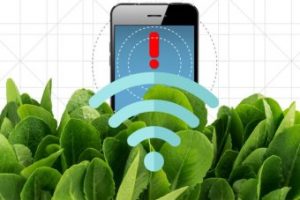A team of scientists from the Massachusetts Institute of Technology (MIT) embedded carbon nanotubes in spinach leaves which emitted a signal when they detected nitroaromatics — a chemical compound used in landmines and other explosives.
 Through the nanotubes, which are one ten-thousandth the diameter of a human hair, the plant can detect the chemicals through the air and groundwater.
Through the nanotubes, which are one ten-thousandth the diameter of a human hair, the plant can detect the chemicals through the air and groundwater.
Researchers also applied a solution of nanoparticles to the underside of the leaves and placed sensors into a leaf layer (known as the mesophyll) where most photosynthesis takes place.
To read the signals the plants give off, researchers shine a laser on the leaves which prompts the carbon nanotubes to emit a near-infrared fluorescent light.
That light is picked up by using an infrared camera connected to a Raspberry Pi, a credit-card-sized computer, similar to the computer used in a smartphone.
The Raspberry Pi then sends an email to the phone, alerting the owner to the presence and size of an explosive.
By engineering these plants to act as chemical sensors, scientists can perform monitoring tasks in public spaces and identify potential terrorism threats at mass-attended events, said Michael Strano, professor of chemical engineering at MIT.
“They could also be used on the periphery of a chemical plant and even fracking sites.”
Plants are ideal for this purpose as they have extensive root networks to monitor groundwater, are self-repairing, and are naturally adaptive to where they exist.
“If you think of taking your iPhone or a piece of electronics outside and having it adapt to the temperature changes, it’s actually an engineering challenge,” said Professor Strano.
 “We look at the plant for a great starting point for technology.
“We look at the plant for a great starting point for technology.
“It’s amazing it hasn’t been explored for this purpose.”
The researchers can pick up the warning signal from about one metre away, but are working to increase that distance.
As well as spinach, researchers used rocket and watercress as chemical sensors, choosing to use plants that were commonly available.
“We wanted to show that these techniques work with plants found in the wild or a nursery, rather than using genetically-engineered plants,” Professor Strano said.
By using plants that already exist in the wild, the need to create new organisms which may have problems surviving is eliminated.
